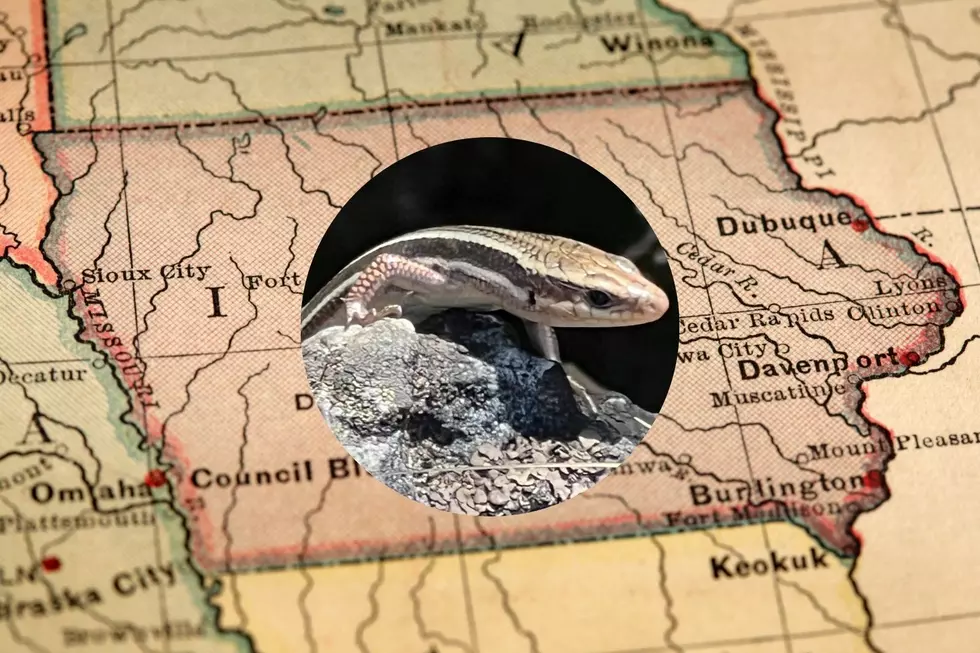
Iowa Has Wild Lizards!
Read that title again.

Iowa HAS wild lizards. And now, I have proof!
My family and I get out a ton and hike and while my wife tends to enjoy the foliage, flowers, and scenery more; I love the animals. You know curious odd bugs, frogs, and wildlife in general, which brings me to the title of my article. Yes! Apparently, 5 separate lizard species do call Iowa home, at least in some capacity. And I had my first experience with one in the wild, which is apparently quite rare!
At first, I thought I had stumbled upon a snake, but I was shocked when it scurried up a tree in front of me.
I never really thought we would have surviving, wild lizard populations. I mean, they are reptiles so the cold doesn't suit them. But hey, if a snake can survive the cold, harsh Iowa winters, why can't a lizard, right? But there I was hiking this weekend when I saw this beauty (RIP Croc Hunter).
This might be one of the coolest pictures I have ever taken in Iowa. This, my friends, is a Five-Lined Skink.
This is what is known as a Five-Lined Skink. And I, my family, and everyone I know personally have never seen one alive in the wild before. That is until I stumbled upon 3 of them basking in the sunlight of the rather famous Backbone State Park, in one of its most highly trafficked landmarks, the Devil's Backbone formation itself. If you didn't look closely, you would have thought he was a salamander or maybe a newt. But I was astonished to see the beautiful blue and vibrant yellow colors on a rather dry, not slimy reptile body. I even thought he was a snake at first.
There had been no sighting confirmed for Delaware County in their online mapping system (iowaherps.com) until I made my report.
Huge bonus, according to the Iowa Herps online map, I may be one of the first persons (possibly only) to identify and document this lizard in Delaware County.
Five-lined skinks typically measure just over 3 inches long but can be up to 8 inches including their delicate tails. They sport glossy black sides and a brown dorsal surface adorned with five prominent longitudinal yellowish stripes. Juveniles boast the bright blue tails, as seen in my photos.
They are found primarily near rocky outcrops on woodland edges or wooded clay bluffs, these skinks exhibit heightened activity in spring, displaying remarkable speed and alertness, making them elusive unless actively sought out. Their secretive nature often contributes to an underestimation of their actual population. They thrive in environments where sunlight meets rocky or wooded habitats, found across eastern Iowa near woodlands with ample sun exposure or in western Iowa along the wooded bluffs of the Missouri River.
One of my favorite photos of the day. This photo was taken on the Devils Backbone formation at Backbone State Park in Iowa's Delaware County.
As they mature, their appearance changes, with juveniles losing their blue tail coloring as they age. Adult females retain the striped pattern, while males tend to adopt a more uniform brown or tan coloration, though faint stripes may still be visible. During the breeding season, males' heads can turn vibrant shades of red or orange, adding to their unique appearance.
In addition to the Five-Lined Skink, Iowa hosts at least 4 other lizard species, albeit in very limited numbers. Among them are the Great Plains Skink, the Northern Prairie Skink, the Six-lined Racerunner, and the legless, Slender Glass Lizard. All these lizards are beneficial to have as they eat insects and are not dangerous or poisonous in any way. That being said, our native populations are not common and are quite rare so please leave them be. If you see them, snap a photo and leave them to their happy bug-eating selves.
As I mentioned, lizards are relatively rare in Iowa compared to other regions with warmer climates and more diverse ecosystems. The state's cooler temperatures and predominantly agricultural landscape limit the abundance and diversity of lizard species. While these lizards may not be as abundant as in other states, their presence underscores the resilience of these creatures in adapting to Iowa's specific environmental conditions. Efforts to protect their habitats and raise awareness about their importance in ecosystems are essential for ensuring their continued survival in our great state of Iowa.
More Iowa Adventures Await You! Check Out My Recommendations:
Photos: Northeast Iowa's Yellow River State Forest
Gallery Credit: Tom Ehlers
Photos: Whitewater Canyon in Bernard, Iowa
Gallery Credit: Tom Drake

